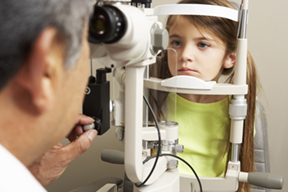 Eye health starts before we’re born. We all know how important prenatal care is, and the impact our ancestry and genetic make up have on us. For a select few, early detection of disease or abnormality can be either sight or life saving!
Eye health starts before we’re born. We all know how important prenatal care is, and the impact our ancestry and genetic make up have on us. For a select few, early detection of disease or abnormality can be either sight or life saving!
In the United States, we are fortunate to have a robust post natal ocular screening and disease prophylaxis program administered in most hospital nurseries. Our pediatricians and nurse practitioners include in their checkups evaluations of alignment, visual function milestones, and the very important “red reflex” test- using a penlight in front of the patient and seeing a red reflection from within the eye, proving a clear optical pathway both in and out of the eye being examined.
Large population studies have shown that refractive errors of myopia, hyperopia, and astigmatism can be detected between the ages of six months and two years. Fortunately, the majority of these changes are transient and no intervention is required. However, a mother who smokes can cause her child to be born with a higher risk of permanent hyperopia, astigmatism, and strabismus.
As a child grows, so do the eyes. The grade school and middle school years are filled with lots of changes for our children. Whether it’s hard to see the blackboard or a ball on the playing field, it’s a pretty straightforward fix – glasses.
Our children’s greatest risk of blindness is from ocular trauma, particularly when playing sports. In fact, multiple studies have indicated over 90 percent of pediatric ocular injuries could have been prevented by simply wearing protective eye goggles. This rule of wearing protective eye goggles, of course, extends beyond just the playing field, and includes such activities as doing chores with the lawnmower in the backyard or a fireworks injury on that special holiday.
Retinal and ocular oncology specialists work tirelessly to protect our children from these very challenges. If a child fails a screening or red-reflex test, we utilize state-of-the-art digital imaging and examination equipment to understand if true pathology is present, and establish a treatment protocol. Potential causes of vision loss associated with a failed red reflex screen include retinoblastoma – the most common childhood ocular cancer, retinopathy of prematurity – the growth of new blood vessels in the eye, occurring in premature infants, or pediatric cataracts. Potential causes of vision loss associated with ocular trauma in kids include a ruptured globe from severe trauma, retinal tear or retinal detachment, or bleeding in the front (hyphema) or back (vitreous hemorrhage) of the eye.
Taking these very simple steps can make large strides in protecting our children’s eyes. Prenatal counseling of expectant mothers, robust and diligent screening of newborns and toddlers – particularly those with risk factors – are easy, and prevent vision loss long term.
Most importantly, preventing eye trauma through education, and insisting on eye protection, are crucial in protecting our children’s precious eyesight. If you see a child at risk, please say or do something. Hopefully, someone would do it for your child and eliminate a lifetime of loss.
 Kapil G. Kapoor, MD completed medical school at Ohio State University, residency at the University of Texas Medical Branch-Galveston and a fellowship at The Mayo Clinic.
Kapil G. Kapoor, MD completed medical school at Ohio State University, residency at the University of Texas Medical Branch-Galveston and a fellowship at The Mayo Clinic.
Dr. Kapoor is a Board certified ophthalmologist specializing in vitreoretinal surgery. www.wagnerretina.com.

